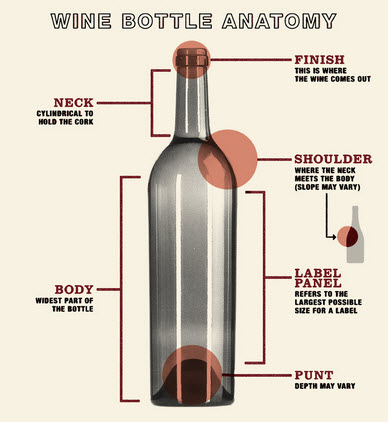The vocabulary of wine can be a complicated lexicon of terms both physical and figurative. But if there is one set of words you should know, it’s the parts of the bottle. After all, there are just eight of them that are common to pretty much all wine bottles, even though their shapes and sizes might differ.

There are just eight parts to a wine bottle you need to know – give or take. Image source: winery sage.
Starting from the top, here are the parts of the wine bottle.
1. Closure: Simply put, this is hole at the top of the bottle that you stop up with a cork or screw cap.
2. Capsule: This is the word for the foil or thin metal wrapping that goes around the closure – you know, the part you have to cut through in order to pry out the cork with your corkscrew, or that’s attached to the screw cap.
3. Neck: This is the thin part of the bottle just below closure.
4. Shoulder: Like on the human body, this is the part of the bottle between the neck and the body, where it starts to get thicker.
5. Body: The main, cylindrical (or bulb-shaped) part of the bottle that contains the majority of the liquid.
6. Label: Technically not part of the bottle, this is where you’ll find all the information on the wine inside, including the name of the winery, when and where it was made, and what kinds of grapes were used.
7. Heel: The very bottom of the bottle that forms its base and usually has those little bumps or scorings on it.
8. Punt: Probably my favorite part of the bottle thanks to its name. This is the indentation or dimple on the bottom of the bottle. The punt is not actually part of all bottles, and can vary in depth quite a bit. But you’ll find it on particular kinds of wine like Champagne. Though it is a bit of a relic from the days when bottles were hand-blown and shaped with “pontil,” the punt actually serves a few purposes. It allows you to pour a wine one-handed, it makes the bottle more stable when standing upright as well as making it stronger in general so that it can hold high-pressure wines like Champagne, and it also helps settle out any unwanted sediments in the wine.
There you have it. There are just eight parts to a wine bottle…compared to over 800 bones and muscles in the human body. That should be easy enough to remember even after you’ve finished drinking the bottle!

